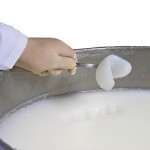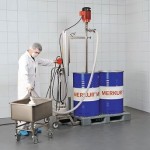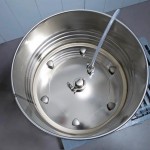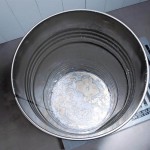Handling high-viscosity, pasty fluids that are just non flowing is a critical point in the production process. A cream and ointment manufacturer decided to use the Viscoflux mobile drum emptying system for petroleum jelly, a raw material which is supplied in barrels. The Flux system not only enables almost complete emptying but is also mobile and can thus be used at various points in the production plant.
The author: Walter Pieper Freelance journalist
A European pharmaceutical company manufactures creams and ointments for treating skin irritation. In a precisely specified production process, the ingredients and additives are mixed together before the ointment is filled into containers. One important constituent of these ointments is petroleum jelly, a substance that is not free-flowing. The jelly is supplied in 200 litre drums with beads.
For about ten years, the company had been using a stationary system with a stainless steel reciprocating pump guided by pneumatic cyl-inders to empty the drums. This transfer system was getting on in years and starting to cause technical problems. In particular, the downtime due to wear was considerable. The manufacturer initially investigated whether comprehensive repair would be worthwhile; however, a cost analysis quickly revealed that refurbishing the system would be extremely expensive.
The former system also had a few disadvantages. The pulsating filling process and high shearing forces had a negative influence on product quality, for instance. Added to this was the high noise level to which staff were exposed owing to the loudness of the reciprocating pump. Moreover, the system used compressed air, which meant lower efficiency compared, for example, to electric systems. Another major drawback was that it was heavy and difficult to dismantle and that its position was fixed. The company was therefore looking for a mobile system that could be better integrated into the production process.
One of the alternatives considered was heating the raw material to make it pumpable, e.g. for using a centrifugal pump. However, this approach was handicapped by the huge amount of time lost as a result of the long heating process (about 24 hours), the purchase costs for the heating cabinet and the high energy costs. Another disadvantage was the unequal exchange of heat, which is substantially higher at the edge of the drum than in the core area. An additional mixer would have been required to re-homogenise the fluid, leading to a deterioration in quality.
After weighing up the pros and cons, the company finally opted for Flux’s Viscoflux mobile drum emptying system.
Low residual amount
The system consists of a mobile lifting device with an integrated override clutch, motor, eccentric worm-drive pump and follower plate with process seal. Barrels with a wide range of diameters, including conical drums, can be emptied by exchanging the follower plate and the process seal. The pump unit is lowered for pumping by means of a rechargeable battery powered motor until the follower plate touches the material. From then on, the lifting sledge is lowered further independently of the pump. During the pumping process, the self-priming eccentric worm-drive pump creates a vacuum underneath the follower plate which pulls the plate down automatically. The system pumps continuously, so that the fluid is handled especially gently.
The petroleum jelly is supplied to the pharmaceutical company in drums with beads. During pumping the flexible process seal adjusts to these beads and, to a certain extent, even to dents in the drum wall. The product is hermetically sealed in this way, ensuring a reliable process even if pumping is interrupted. Almost no residual jelly is left behind on the drum wall. The amount remaining in the barrel is less than 1 %. This represents an additional benefit for the pharmaceutical company because the system makes very efficient use of the fluid and no subsequent cleaning is neces-sary. The mobile Flux drum emptying system is available for several different diameters as standard. The Pharma Food Cosmetic version can also be used for conical drums, even if the fluid is supplied in aseptic bags. These bags do not even have to be fixed. The residual amount that can be achieved here is still less than 2%.
Since the pharmaceutical company uses petroleum jelly at various points in the production plant, the system’s mobility is another decisive advantage. Thanks to the integrated mobile lifting device, it can easily be moved to the required pumping location or cleaning station. This is even possible if the place of use is located on a different floor because its compact design means it can be transported in a lift.
Conclusion
Many products that have to be conveyed are so viscous that they are not free-flowing. Apart from petroleum jelly, this also applies to creams, jellies, pastes and paints used in the pharmaceutical, cosmetic and other industries, e.g. for greases up to class 3, coatings, sealing or wood filling compounds, varnishes and Locher paste. In the food sector, conical drums with aseptic bags are often employed, for example to transport tomato purée. The Viscoflux mobile drum emptying system offers enormous advantages if these fluids need to be pumped out of drums. In addition to the very gentle media transport, these benefits particularly include sizeable cost and energy savings, physical flexibility and additional process reliability.
cpp-net.com/0312429
Overview of the drum emptying system
Facts & figures
- The standard drum diameters are 560 and 571 mm, Pharma Food Cosmetic version also for conical drums with a diameter of 550 mm at the top and 515 mm at the bottom, also with aseptic bags. Other drum and container diameters can be supplied on request.
- The residual quantity in the drum is less than 1 % or less than 2 % in the case of aseptic bags
- Mobile use – no crane or fork-lift truck required
- Gentle transfer, no changes to the structure of the fluid
- Easy to dismantle, small footprint
- Flexible modular system, individual components tailored to the medium and the drum
- Pharma Food Cosmetic version is resistant to aggressive cleaning agents
- No need to fix aseptic bags
Share:










